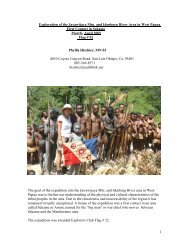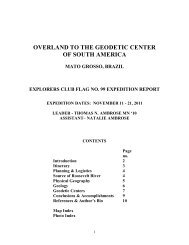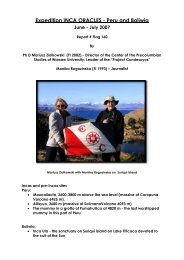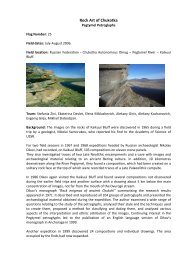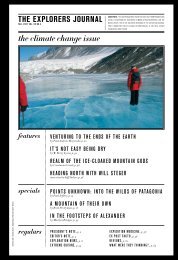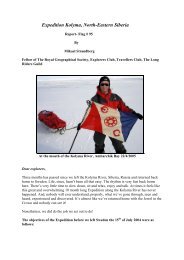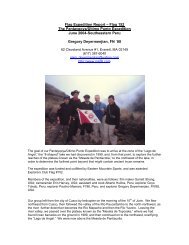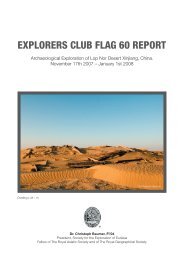the explorers journal the global adventure issue - The Explorers Club
the explorers journal the global adventure issue - The Explorers Club
the explorers journal the global adventure issue - The Explorers Club
- No tags were found...
Create successful ePaper yourself
Turn your PDF publications into a flip-book with our unique Google optimized e-Paper software.
Geoffrey E. Clark, third from left, and his party unfurl <strong>the</strong> <strong>explorers</strong> club flag at Greely’s Camp Clay at Cape Sabine. Photo by Gino Del Guerciowithin seven hours of <strong>the</strong> accident in one of <strong>the</strong> mostremote spots on <strong>the</strong> planet. Scott’s accident clearlydemonstrated that even with modern equipment, wewere still at <strong>the</strong> mercy of <strong>the</strong> elements—conditions asunforgiving today as <strong>the</strong>y were in Greely’s time.Meanwhile, <strong>the</strong> team questioned whe<strong>the</strong>r <strong>the</strong>yshould continue with <strong>the</strong> expedition. Fortunately,Scott’s injuries were limited to “only” a puncturedlung, five fractured ribs, a dislocated clavicle, andsevere soft-t<strong>issue</strong> trauma. From his hospital bedScott urged his team mates to continue—which<strong>the</strong>y did, albeit shorthanded.Steve paddled<strong>the</strong> damaged kayakalone, and James Shedd,who had already provenhimself an accomplishedstill photographer, tookup Scott’s video cameraand continued shootingen route. <strong>The</strong> rest of <strong>the</strong>expedition’s long stretchesover open waterproved to be uneventfulexcept for numerous encounters with enormous,easily provoked walruses; <strong>the</strong> team was acutelyaware of <strong>the</strong>ir unpredictability and how easily <strong>the</strong>ycould destroy a kayak.After six weeks of kayaking down <strong>the</strong> coast, <strong>the</strong>team arrived at its destination on Cape Sabineand met up with Gino, Tom, Simon, and me. Wewere all very moved to see <strong>the</strong> remains of CampClay where so many men had suffered and died inmisery. As a final tribute to Greely and his men, weheld a brief ceremony on Cemetery Ridge where<strong>the</strong> first of <strong>the</strong> many to die were buried.I read a passage to <strong>the</strong> team from Greely’sown Book of Common Prayer—lent to us by JaneGreely—which he had used to conduct Sundayservices and to bury his party’s dead. Our lastact before leaving was to unfurl <strong>the</strong> <strong>Explorers</strong><strong>Club</strong> Flag at <strong>the</strong> plaque placed at Camp Clay byCommander Donald Macmillan for <strong>the</strong> NationalGeographic Society in 1924.To this day, <strong>the</strong> question of cannibalism andwho participated remains unresolved. We foundGreely’s tent site and <strong>the</strong> burial ground—CemeteryRidge—only a few meters apart. It seems inconceivablethat bodies could have been neatly dissectedwithout being observed by at least some of <strong>the</strong> survivors.Perhaps Greely himself was so incapacitatedthat he was unable to get out of <strong>the</strong> tent. We willnever know for sure just what happened.From our retrace of his route, it was clearthat Greely’s expedition was a extraordinary accomplishment,considering <strong>the</strong> time of year, <strong>the</strong>limitations in equipment, and <strong>the</strong> relative inexperienceof Greely and his men. In his memoir, ThreeYears of Arctic Service, Greely noted, “<strong>The</strong> retreatfrom Fort Conger to Cape Sabine involved overfour hundred miles’ travel by boats, and fully ahundred with sledge and boat; <strong>the</strong> greater partof which was madeunder circumstances ofsuch great peril or imminenceof danger asto test to <strong>the</strong> utmost <strong>the</strong>courage, coolness, andendurance of any party,and <strong>the</strong> capacity of anycommander.”Despite a great dealof subsequent criticism,<strong>the</strong> fact remains thatGreely accomplished hismission, bringing all of his records and supplies toCape Sabine. His records, meticulously tabulatedin a large two-volume report, were eventually compiledby NOAA, along with data collected by <strong>the</strong>o<strong>the</strong>r expeditions of <strong>the</strong> First International PolarYear—information contained within <strong>the</strong> baselinefor studies now being carried out under <strong>the</strong> aegisof <strong>the</strong> Fourth International Polar Year. Had <strong>the</strong>War Department completed <strong>the</strong>ir mission and left<strong>the</strong> promised supplies, Greely no doubt wouldhave been able to winter over without loss of life.As late as 1924, an article in <strong>the</strong> New York Timescriticized <strong>the</strong> expedition as being a tragic wasteof time. In a furious response Greely replied thatit was not a “pole-seeking <strong>adventure</strong>,” but a scientificenterprise, and “<strong>the</strong> Greely expedition was anextraordinary success. <strong>The</strong> relief expeditions managedfrom Washington were ghastly failures.”biographyA member of <strong>The</strong> <strong>Explorers</strong> <strong>Club</strong> since 1988, Geoffrey E. Clark,M.D., is a retired gastroenterologist and entrepreneur fromPortsmouth, NH. He has traveled extensively in <strong>the</strong> CanadianArctic doing research and reconnaissance for <strong>the</strong> productionof <strong>the</strong> highly acclaimed film, Abandoned in <strong>the</strong> Arctic.<strong>the</strong> <strong>explorers</strong> <strong>journal</strong>



